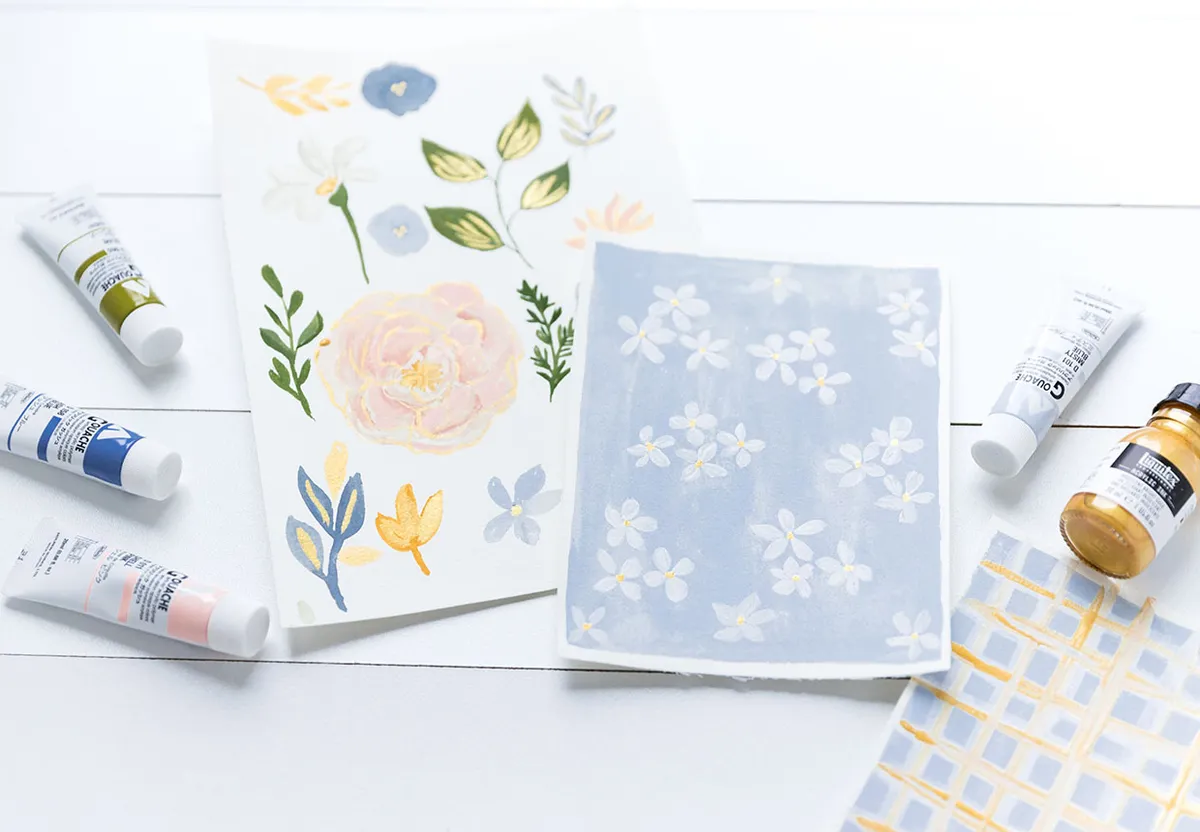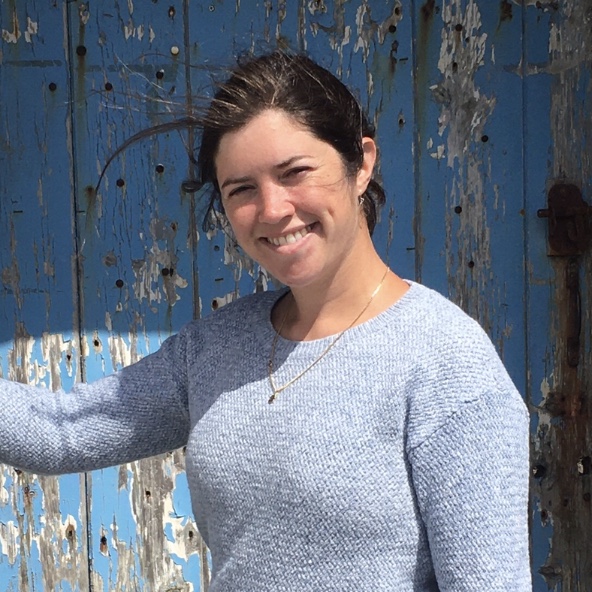Gouache paints and watercolours are both versatile mediums which can be used to create a variety of stunning effects.
While both paints are water-based, they have very different qualities, so consider what results you’d like to achieve before making your choice.
So what’s the difference between gouache and watercolours? The main difference is that gouache paints are opaque, while watercolour paints are transparent.
Gouache paints were traditionally favoured by illustrators, who loved the bold colours and the ability to create flat-looking blocks of paint. However, in recent years they’ve become increasingly popular with mainstream artists.
Watercolours look more delicate due to their translucent nature, but can be layered to achieve deeper shades.
Watercolour paints tend to be cheaper and easy to find, but we’d recommend opting for the best quality you can afford to avoid disappointment. Gouache paints are usually more expensive, partly because the medium is less widely used.
Gouache vs watercolour: which is best?
Gouache paint pros

1. Bold blocks of paint
Gouache paint has a matt, opaque finish which lends itself well to illustration techniques.
While it can look a little flat, this 2D appearance can force you to think more about shape and form in your art. This makes it a great option for those times when you’re stuck in a creative rut!
2. Amazing colours
Gouache paints are known for their richly pigmented colours, which makes them incredibly satisfying to work with.
You can buy gouache in tubes of pre-mixed colours if you don’t want to spend lots of time blending different hues.
There’s a rainbow of brilliant shades to choose from, ranging from soft pastels to highly pigmented primary colours.
3. Work from dark to light
When you’re working with watercolours, it’s recommended that you work from light to dark. However, when you’re using gouache you can work from dark to light, as the paints are thicker and more opaque.
If the paint isn’t looking as bright as you’d like, simply blend in a little white gouache.
4. Fast drying times
If you like to paint quickly, gouache is your friend! It dries out very quickly, especially if you haven’t blended it with too much water.
This means you can achieve a lot in a short painting session, as there’s less waiting around.
5. Layer like a pro
Gouache paints layer beautifully on top of one another, but some care is needed. As we’ve already mentioned, the opaque nature of the paint makes it easy to go over darker shades with a lighter colour.
Gouache paint cons
1. Water reactivates the paints
While gouache paints are great for layering, they are still water-based paints, meaning that some care is needed.
If you use too much water you can reactivate the layer of paint underneath, leading to unwanted mixing!
However, if this is a problem you can buy acrylic gouache paints which are permanent once dry.
2. Gouache dries too fast
While gouache’s short drying time is generally a positive, it can also be a major source of frustration! If you work too slowly, you’ll find that your palette dries up in no time.
A stay wet palette can buy you a little time, so we’d recommend having one on hand when you’re working with gouache.
3. Patchy colours
If you blend your paints with too much water, they can end up looking uneven.
Don’t try to thin your gouache to achieve washes, as you would with watercolours. If you want to make the colours paler, just mix in some white gouache.
Top tip: if you buy a gouache paint set, we’d recommend buying an extra tube of white gouache separately. You’ll get through it very quickly!
4. Gouache can go mouldy
Gouache doesn’t cope well in very hot climates and can even go mouldy due to its high water content.
Artist Cécile Yadro has some great tips on how to prevent gouache moulding so that your paints stay usable.
Gouache is also unsuitable for use in very cold climates, as it can freeze.
5. Cracking
Gouache paint can crack if you apply it too thickly. Luckily, you can fix the problem if you notice cracking on your painting.
Rub the area with sand paper before repainting it, which allows you to correct your mistake.
To prevent your paintings cracking, it’s a good idea to use thin layers of paint and try to avoid working on flexible surfaces when painting. For example, if you work in a sketchbook keep the pages as flat as possible.
Discover the best gouache paint sets
Can’t wait to give gouache paint a go? Get started with Gathered’s best gouache paint set recommendations.
Watercolour paint pros

1. Translucent paints
Watercolour’s biggest appeal comes from its beautifully luminous transparency. This can be used to create paintings that are full of life and areas of interest.
For example, you could overlap the petals of a flower and make them look as though the light is shining through them.
2. Subtle colours or bright shades
You can thin watercolour paints with water until you get the palest hints of colour. This allows you to create very subtle and delicate-looking paintings.
On the other hand, you can use less water for more intense colours if you want more vibrant results.
3. Create flowing artwork
When you’re using watercolours, colours can flow into each other if they’re still wet. This can create stunning (and sometimes accidental!) effects.
This unpredictability is part of watercolour’s charm, but you can also use the fluid quality of the paint to deliberately create unusual results. Take a look at our watercolour techniques guide to pick up new tricks and tips.
4. Short drying time
Watercolour paints dry quickly compared to some other mediums (especially oils and acrylics). The drying time will vary depending on how much water you use – if you saturate your paper with too much water, it’s likely to take a long time to dry out.
5. Affordable and accessible
Watercolour paints are one of the cheapest ways to get into painting. You can easily find budget paint sets and even good quality watercolours are unlikely to break the bank.
You can get hold of the materials you need and learn how to produce your own original artwork very quickly.
Watercolour paint cons
1. Can cause warping
It’s easy to add too much water to your paper when working with watercolours. This makes the paper buckle or bend out of shape, which can be very annoying.
Make sure you’re using watercolour paper that’s specifically designed to handle a lot of water.
2. Not great for layering
Unlike gouache, it’s trickier to layer watercolour paints due to their transparency. That’s why most artists recommend working from light to dark when using watercolour paint.
However, you can cheat a bit by using gouache to add details on top of your watercolour layers. If you’re a watercolour artist, it’s always handy to have a tube of white gouache for highlights as this often works better than white watercolour paint.
Watercolours can also be reactivated with water, meaning that the colours beneath can sometimes blend with the colours you apply on top. If you want to achieve similar results without this happening, try using inks instead.
3. Unwanted paint runs
While unintentional paint runs can sometimes look attractive, they can spoil the look of your painting.
If you want to avoid paint runs, wait until an area of your painting is completely dry before applying another colour next to it.
Unwanted paint runs can be soaked up using absorbent paper towels if you act quickly. You can also soak up paint using a paintbrush to remove a mistake using a technique called lifting.
4. Colours change when dry
Watercolour paints lighten as they dry, which can cause issues if you’re trying to match colours exactly.
You can keep this in mind as you work and over time you’ll learn how to compensate for this effect. It’s just a matter of practice and experience!
5. Muddy colours
Watercolours flow naturally into one another when they’re wet. This can be brilliant for blending, but when too many colours run together your painting can end up looking muddy. Watch out for this when you’re painting!
Watercolour vs gouache: choose the right medium for the task
Watercolour and gouache are water-based painting mediums which can both be used to produce impressive art.
The medium you choose will largely depend on your subject matter and the effects you want to achieve. The two types of paint can be used separately, but they complement each other well.
Still not sure what paint to use? Take the time to consider other mediums to make your creativity shine!
Compare gouache vs acrylic for your next painting
Acrylic paint behaves very differently to watercolour and gouache, but it’s well worth adding to your repertoire.
See how it compares with gouache in our detailed gouache vs acrylic paint feature.

